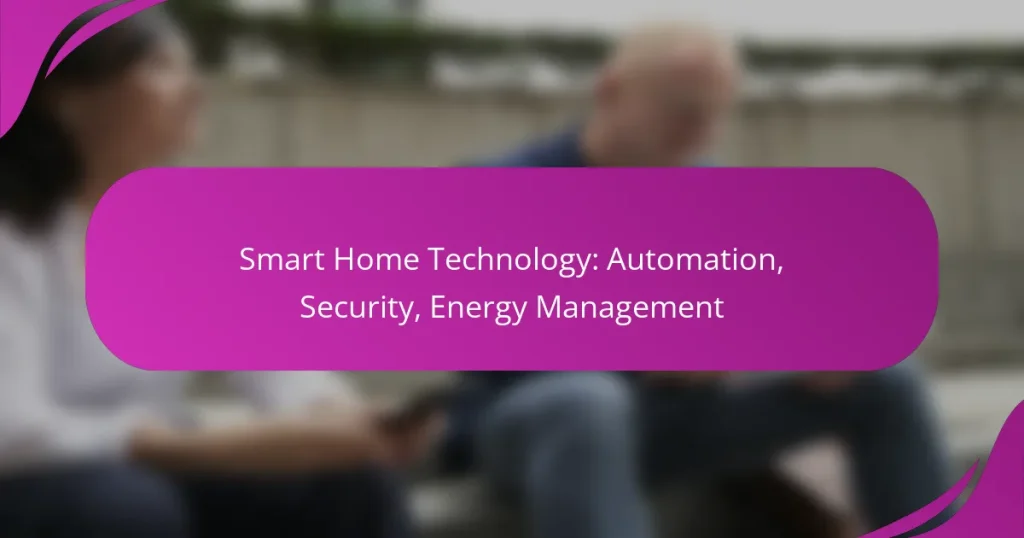Smart home technology revolutionizes the way we live by integrating automation, security, and energy management into our daily routines. With devices like Google Nest Hub and Amazon Echo Plus, homeowners can enhance convenience while ensuring their property is secure and energy-efficient. These systems not only provide real-time monitoring and alerts but also optimize energy consumption, leading to significant cost savings.
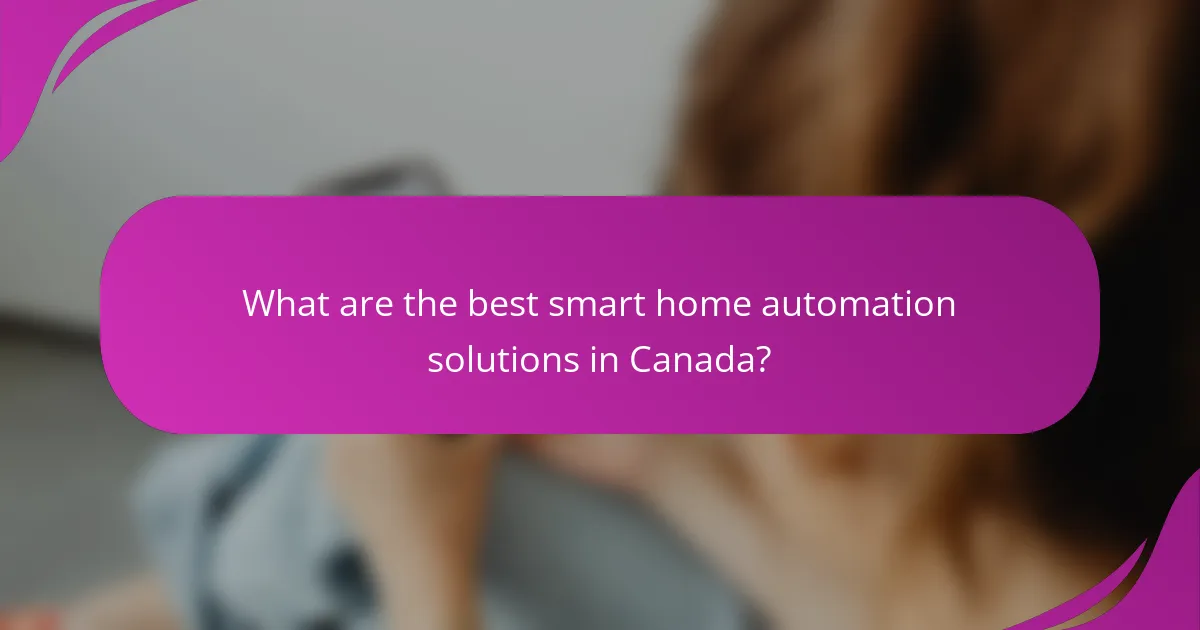
What are the best smart home automation solutions in Canada?
The best smart home automation solutions in Canada include devices that enhance convenience, security, and energy efficiency. Popular options like Google Nest Hub, Amazon Echo Plus, and Apple HomePod offer unique features that cater to different user preferences and needs.
Google Nest Hub
The Google Nest Hub is a versatile smart display that integrates seamlessly with Google Assistant, allowing users to control various smart home devices through voice commands or touch. It features a user-friendly interface that displays information such as weather updates, calendar events, and streaming services.
When considering the Nest Hub, note its compatibility with a wide range of smart home products, including lights, thermostats, and security cameras. It’s particularly beneficial for those who already use Google services, as it can easily sync with Google Home and other applications.
Amazon Echo Plus
The Amazon Echo Plus serves as both a smart speaker and a hub for controlling compatible smart home devices. With built-in Zigbee support, it can connect directly to various devices without needing additional hubs, making setup simpler.
For users in Canada, the Echo Plus offers access to Alexa’s extensive skills and routines, allowing for customized automation scenarios. It’s ideal for those who prioritize voice control and want to integrate shopping, music, and home management into one device.
Apple HomePod
The Apple HomePod is designed for users deeply embedded in the Apple ecosystem. It offers high-quality audio performance and integrates with Siri for voice commands, making it a great choice for music lovers who also want smart home functionality.
While the HomePod excels in sound quality and privacy, it has a more limited range of compatible devices compared to its competitors. Users should consider whether their existing smart home devices are compatible with Apple’s HomeKit before investing in this solution.
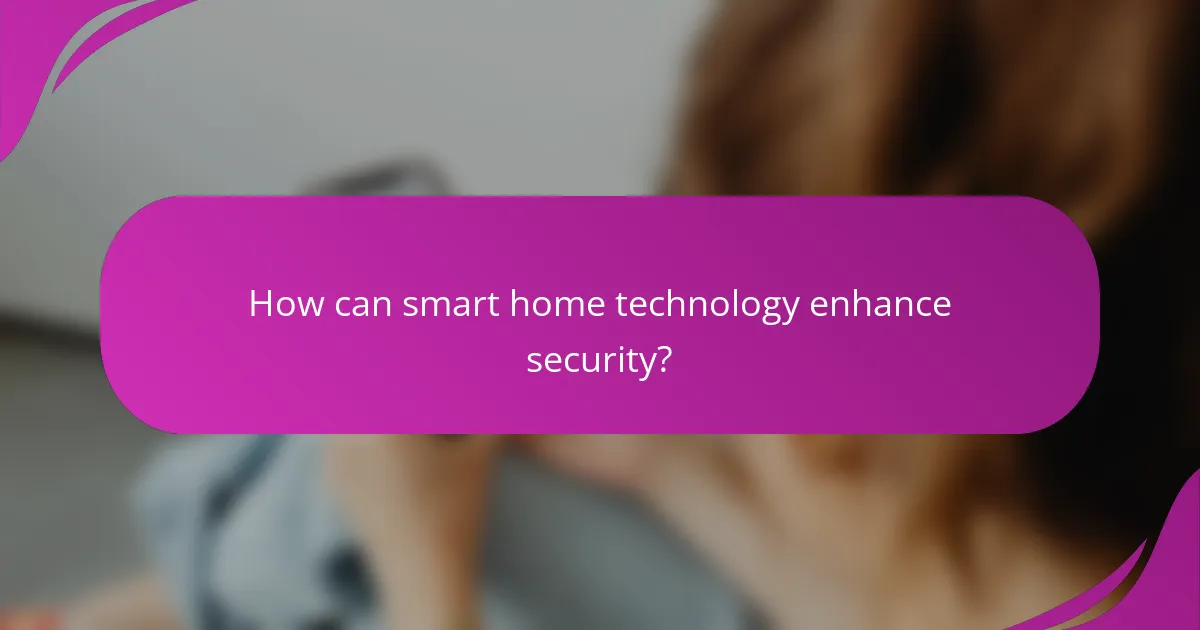
How can smart home technology enhance security?
Smart home technology enhances security by integrating devices that monitor and control access to your home. These systems provide real-time alerts, video surveillance, and remote management, making it easier to protect your property and loved ones.
Ring Video Doorbell
The Ring Video Doorbell allows homeowners to see and communicate with visitors at their door via a smartphone app. It features high-definition video, two-way audio, and motion detection, which sends alerts when someone approaches your door.
When considering a Ring Video Doorbell, check for compatibility with your existing smart home ecosystem. It typically requires a stable Wi-Fi connection and can be powered by a battery or hardwired. Installation is straightforward, often taking less than an hour.
Arlo Pro 4 Security Camera
The Arlo Pro 4 Security Camera offers high-resolution video and advanced features like color night vision and a built-in spotlight. It is designed for both indoor and outdoor use, providing flexibility in monitoring various areas of your property.
Key considerations for the Arlo Pro 4 include its wireless functionality, which requires a reliable Wi-Fi connection, and its rechargeable battery, which can last several months. Users should also evaluate subscription plans for cloud storage, as some features may be limited without a paid plan.
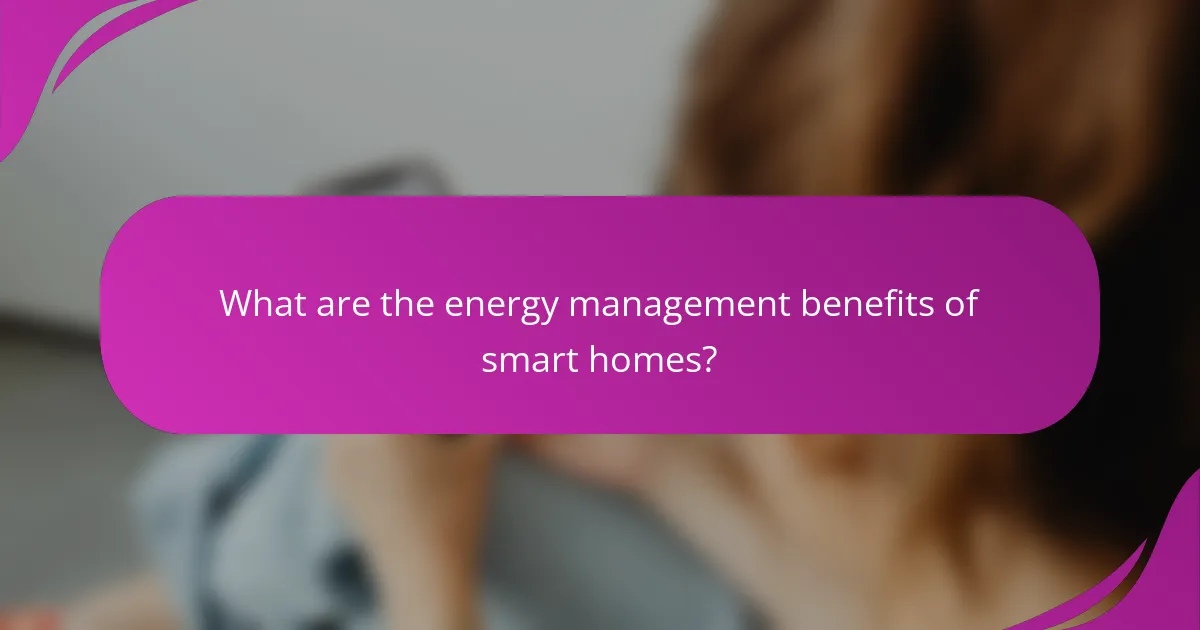
What are the energy management benefits of smart homes?
Smart homes offer significant energy management benefits by optimizing energy consumption and reducing costs. Through automation and smart devices, homeowners can monitor usage patterns, adjust settings remotely, and achieve greater efficiency.
Ecobee SmartThermostat
The Ecobee SmartThermostat helps manage heating and cooling efficiently by learning your schedule and preferences. It can adjust temperatures automatically based on occupancy, which can lead to energy savings of around 20% on heating and cooling bills.
When using the Ecobee, consider setting up the Home and Away modes to maximize savings. The device also integrates with various smart home systems, allowing for seamless control through voice commands or mobile apps.
Philips Hue Smart Lighting
Philips Hue Smart Lighting allows users to control their home lighting remotely, which can lead to reduced energy consumption. By scheduling lights to turn off when not in use or adjusting brightness levels, homeowners can save on electricity costs.
To maximize the benefits of Philips Hue, utilize features like scene setting and automation based on time or occupancy. This not only enhances convenience but also ensures lights are only used when necessary, contributing to overall energy efficiency.
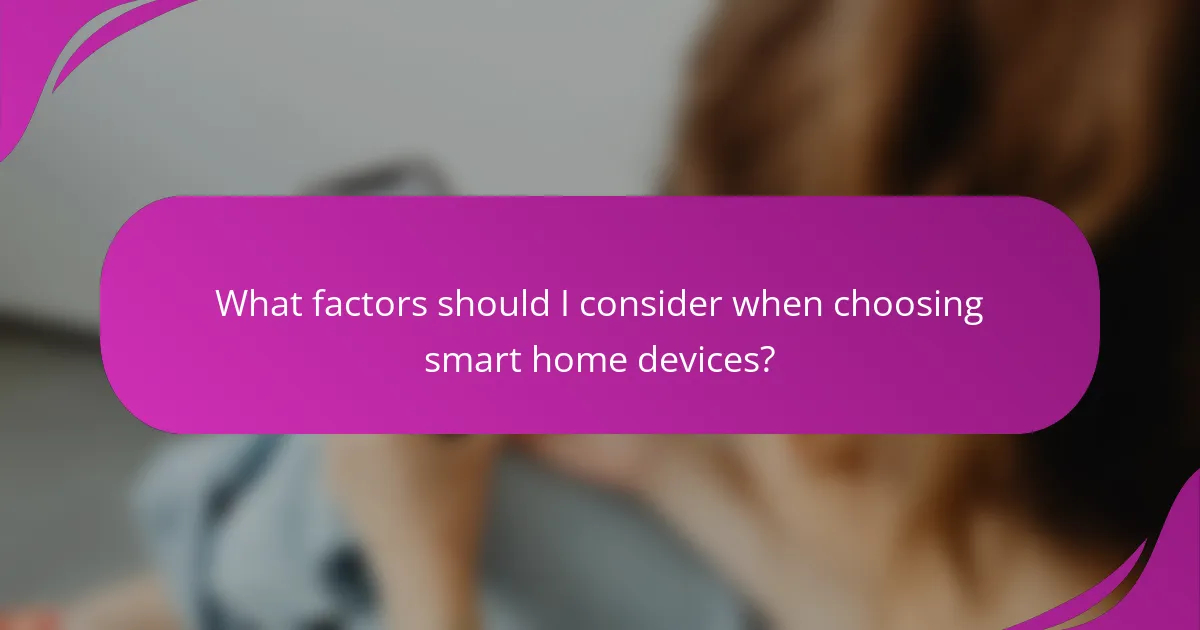
What factors should I consider when choosing smart home devices?
When selecting smart home devices, consider compatibility with your existing systems, ease of installation, and the specific features that meet your needs. These factors will help ensure a seamless integration into your home environment and enhance your overall experience.
Compatibility with existing systems
Compatibility is crucial when choosing smart home devices, as it determines how well new devices will work with your current setup. Check if the devices support common standards like Zigbee, Z-Wave, or Wi-Fi, which can facilitate communication between different brands and types of devices.
For example, if you already have a smart hub, ensure that any new devices can connect to it. This will prevent the need for multiple apps or systems to manage your smart home, simplifying your user experience.
Ease of installation
Ease of installation can significantly impact your satisfaction with smart home devices. Many devices are designed for simple DIY installation, often requiring minimal tools and time. Look for products that offer clear instructions and user-friendly interfaces.
Consider whether you need professional installation, especially for more complex systems like security cameras or smart thermostats. Weigh the costs of professional help against your comfort level with technology; sometimes, a small investment in installation can save time and frustration.
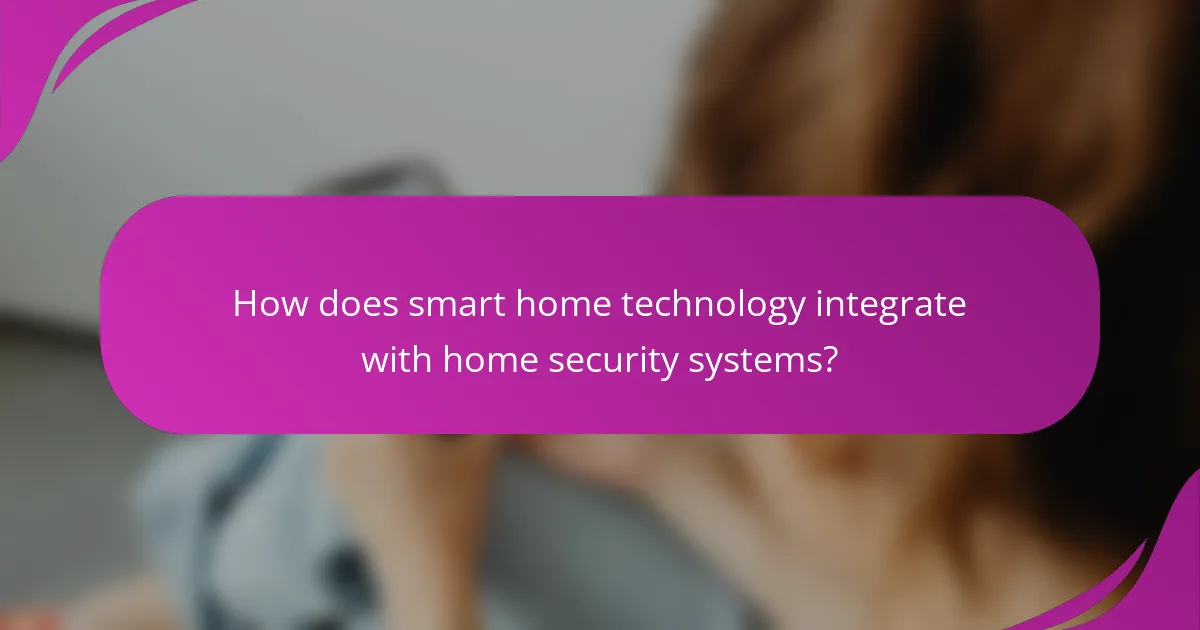
How does smart home technology integrate with home security systems?
Smart home technology enhances home security systems by connecting devices like cameras, alarms, and locks through a centralized platform. This integration allows for real-time monitoring, remote control, and automation, providing homeowners with increased safety and convenience.
Smart locks integration
Smart locks work by allowing homeowners to control access to their property remotely via smartphone apps or keypads. They can be programmed to grant temporary access to guests or service personnel, which can be particularly useful for vacation rentals or deliveries.
When integrating smart locks with a home security system, consider compatibility with existing devices and the security protocols used. Look for locks that offer features like encryption and two-factor authentication to enhance security.
Alarm system compatibility
Many modern alarm systems can integrate with smart home technology, allowing for seamless communication between devices. This means that when an alarm is triggered, smart cameras can automatically start recording, and notifications can be sent directly to your smartphone.
When choosing an alarm system, ensure it supports integration with other smart devices, such as motion sensors and smart lights. This compatibility can enhance your overall security setup, making it more responsive and effective in deterring intruders.
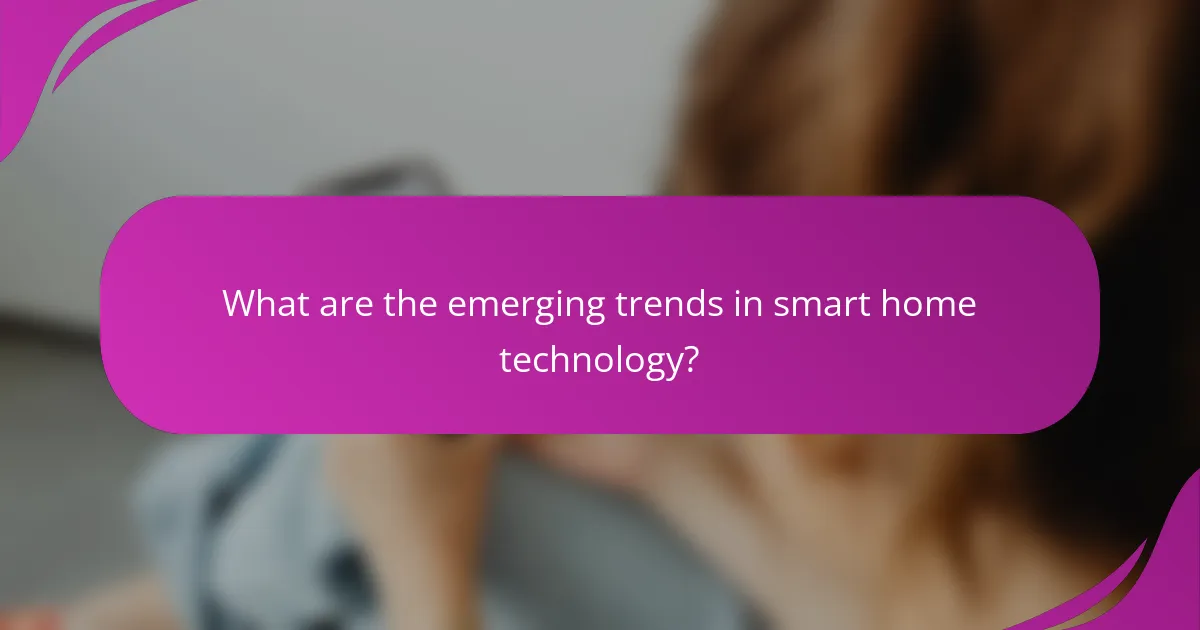
What are the emerging trends in smart home technology?
Emerging trends in smart home technology include advancements in automation, heightened attention to privacy and security, and improved energy management systems. These trends reflect a growing consumer demand for convenience, safety, and efficiency in home environments.
AI-driven automation
AI-driven automation enhances smart home technology by enabling devices to learn user preferences and adapt accordingly. For example, smart thermostats can adjust heating and cooling based on historical usage patterns, optimizing energy consumption and comfort.
Home automation systems can integrate various devices, such as lighting, security cameras, and appliances, allowing for seamless control through a single interface. This integration often uses machine learning algorithms to predict user behavior, making the system more intuitive over time.
Increased focus on privacy and security
As smart home technology becomes more prevalent, there is an increased focus on privacy and security to protect user data. Consumers are becoming more aware of potential vulnerabilities, prompting manufacturers to enhance encryption and authentication measures in their devices.
Homeowners should consider using devices that comply with established security standards and regularly update their software to mitigate risks. Additionally, employing strong passwords and enabling two-factor authentication can further safeguard smart home systems from unauthorized access.
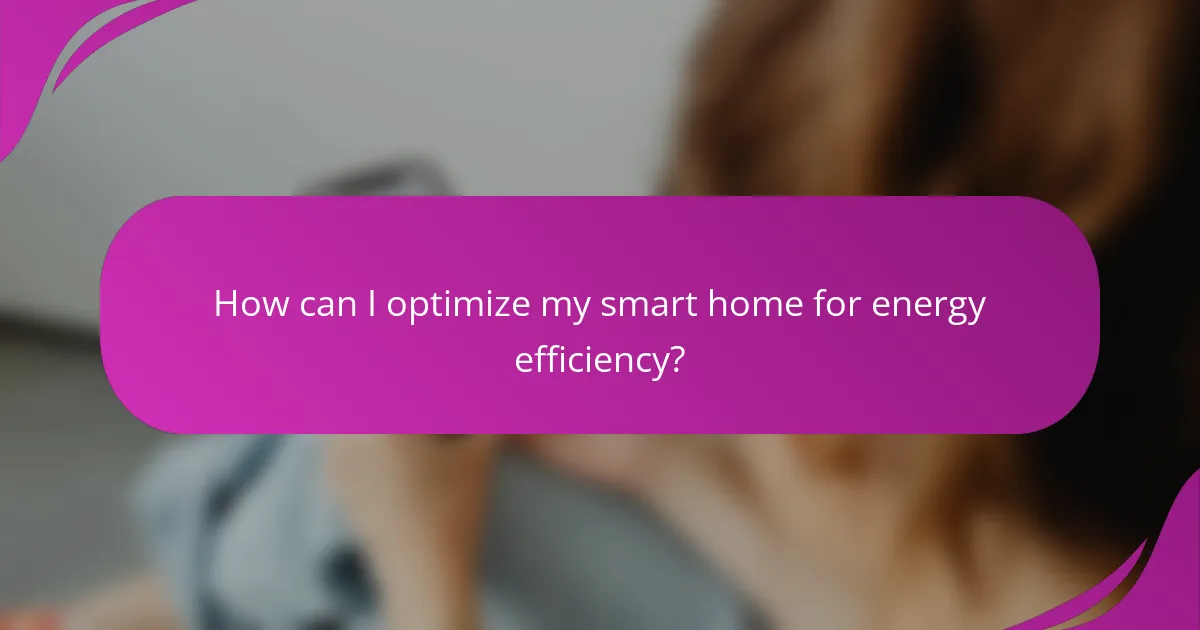
How can I optimize my smart home for energy efficiency?
To optimize your smart home for energy efficiency, focus on integrating devices that can be controlled remotely and automate their usage based on your needs. This approach can significantly reduce energy consumption and lower utility bills.
Using smart plugs
Smart plugs are a simple yet effective way to enhance energy efficiency in your home. By allowing you to control devices remotely, you can turn off appliances that are not in use, preventing phantom energy drain. For example, devices like chargers and coffee makers can be scheduled to power down when not needed.
When selecting smart plugs, look for models that offer energy monitoring features. These can provide insights into how much energy each device consumes, helping you make informed decisions about usage. Consider using smart plugs for high-energy devices like heaters or air conditioners to manage their operation more effectively.
Scheduling devices
Scheduling devices is another key strategy for improving energy efficiency in a smart home. Most smart home systems allow you to set timers for lights, thermostats, and appliances, ensuring they operate only when necessary. For instance, you can program your thermostat to lower the temperature during the night or when you are away from home.
Utilize scheduling features to align device usage with your daily routine. This can lead to significant savings, especially for heating and cooling systems, which account for a large portion of energy bills. Be mindful to adjust schedules seasonally to maximize efficiency throughout the year.

What are the top smart home platforms available in Canada?
The leading smart home platforms in Canada include Google Nest, Amazon Alexa, and Apple HomeKit. Each platform offers unique features for automation, security, and energy management, catering to different user preferences and needs.
Google Nest
Google Nest integrates seamlessly with various smart devices, allowing users to control their home environment through voice commands or the Google Home app. It supports a wide range of products, from thermostats to security cameras, making it a versatile choice for automation.
When considering Google Nest, evaluate its compatibility with your existing devices and the ease of setup. Many users appreciate the user-friendly interface and the ability to create routines for daily tasks, such as adjusting the thermostat or turning on lights at specific times.
Amazon Alexa
Amazon Alexa is another popular smart home platform in Canada, known for its extensive compatibility with third-party devices. Users can control their smart home gadgets using voice commands through Echo devices or the Alexa app, making it convenient for hands-free operation.
One key advantage of Alexa is its skill library, which allows users to add functionalities to their smart home setup. However, ensure that the devices you choose are compatible with Alexa to avoid any integration issues. Regular updates from Amazon also enhance the platform’s capabilities over time.
Apple HomeKit
Apple HomeKit offers a secure and user-friendly smart home experience, particularly for those already invested in the Apple ecosystem. Users can control HomeKit-enabled devices through the Home app or Siri, providing a cohesive interface across Apple devices.
When choosing HomeKit, consider its focus on privacy and security, which is a significant selling point for many users. However, the range of compatible devices may be more limited compared to Google Nest and Amazon Alexa, so check for compatibility with your desired products before committing.
